When the New York Rangers plucked David Quinn out of Boston University to be their head coach nearly three years ago, there was little doubt about how his hiring fit their mission for the next several seasons.
First and foremost, general manager Jeff Gorton wanted a teacher, a man who could coach players about the same age as his Terriers with a flood of youth beginning to roll into the organization. To be sure, the goal was to win as the Blueshirts began their rebuilding project, but preparing a bunch of teenagers and low-20-somethings to do so was going to be a patient and often an up-and-down process.
Now in his third season, Quinn has done an admirable job in many cases, and the front office can count numerous kids who have been growing into bonafide NHL players on the coach’s watch. Yet no one’s record is perfect, and it’s worth considering whether Quinn and the organization may have strayed, if not completely, from the mandate of May 2018, at least somewhat away from it as the club chose to push for a second straight playoff spot in 2020-21.
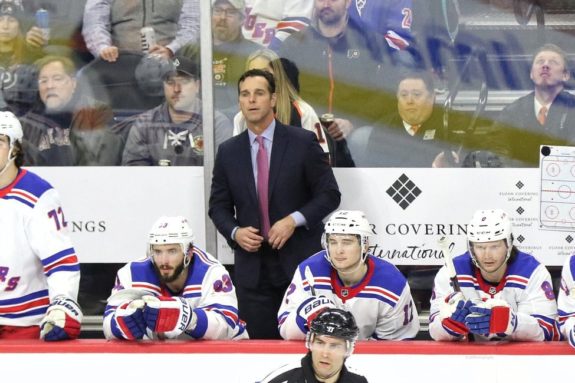
For it’s clear that a decision was made, perhaps by or at a minimum with the blessing of the executive level of the organization, to ride the team’s high-end stars in what now is looking like a largely futile attempt to find a way into the postseason.
What did that mean for the lineup of late? It meant a top-six forward configuration made up entirely of veterans. A defense in which highly-regarded rookie Zac Jones, signed to his entry-level contract earlier this month, fresh off winning a national championship with UMass, got his first look only when Jacob Trouba was injured against the New York Islanders on Tuesday. Mostly, it meant a bunch of talented kids, ones who ostensibly represent the organization’s future, often battling for the equivalent of table scraps when it came to meaningful ice time.
Postseason Pursuit Became the Priority
Was this the correct approach for the organization at this point in time, more than three years after the front office formally announced its coming teardown? The answer, like so many answers in life, isn’t simple.
Team management, both on- and off-ice, saw the chance to make it into the playoffs as an important step in the team’s continued rise back to contention. Organizational confidence, the thinking might have gone, would flow from a berth in the tournament and ultimately benefit the youth in the long run as they experienced the pressure of at least one playoff series this season.
What should be mentioned near the top of this debate, however, is that Quinn is human. He has a dream job and wants to keep it. And sooner or later, if a coach at the highest level of his profession doesn’t start to deliver victories and playoff appearances, he won’t have that job anymore.
Did any of that play into Quinn’s thinking as he leaned on Artemi Panarin, Mika Zibanejad, Chris Kreider and Ryan Strome heavily down the stretch of this COVID-abbreviated season? Perhaps we’ll never know.
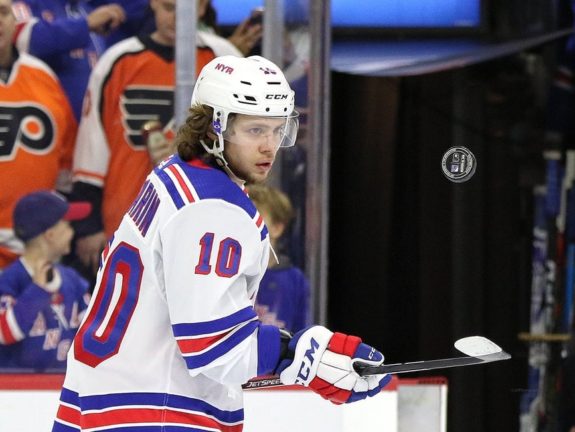
Rather than waste words speculating about whether or not that’s true, we’ll take a look at what was potentially sacrificed in the form of the Rangers’ future to make that push.
Missed Opportunities to Team Young Forwards With Established Stars
Nowhere was the decision to eschew full-on development in favor of a postseason charge more evident than in the top two forward lines. Of course, the coach is going to have Panarin and Zibanejad as nightly fixtures in that mix – but given Quinn’s correct decision to play those two on separate units, the other four spots presented a wealth of invaluable opportunities to team rising kids with the type of elite player they want to eventually become.
Such an alignment can mean so much for young, impressionable players. It gives them a front-row seat for how NHL stars conduct themselves and approach each game. More importantly, it usually means points – in this case, riding the coattails of a pair of players who are amongst the best and most productive in the league at their positions.
So putting Kaapo Kakko on Panarin’s right wing, and leaving him there, means the 20-year-old Finn would have been the beneficiary of Panarin’s pinpoint passes, and likely some easy goals to build his confidence. Surrounding Zibanejad with Vitali Kravtsov and Alexis Lafreniere would have forced the youngsters to learn to keep pace with their center’s dynamic, always-attacking style. And subbing Filip Chytil into Strome’s spot next to Panarin for an extended stretch maybe gives Quinn and the front office a better sense of whether Chytil is at long last about to emerge as a capable second-line center, or better suited to the wing.
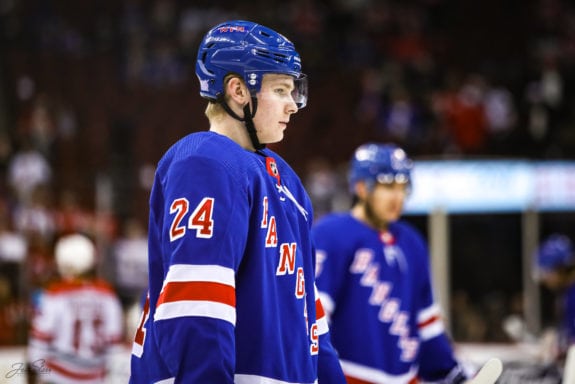
What happened instead: Kakko received several short stretches on the Panarin-Strome line, yet was replaced recently by Colin Blackwell; Zibanejad stayed with Chris Kreider and Pavel Buchnevich on the erstwhile KZB line; Kravtsov became ensconced on the fourth line, and Chytil never seemed to get a top-six shot to show whether his considerable talent is about to translate to bigger offensive numbers in what should have been a critical season for the Rangers to figure out just that.
Quinn’s alternative? Forming a “Kid Line” of Lafreniere, Chytil and Kakko that provided some energy and offense, but represented a unit that saw its ice time significantly limited as the coach rode his top two lines. Lafreniere, Kakko, Chytil and Kravtsov are averaging about 6-9 fewer minutes than Panarin, Zibanejad, Strome and Kreider.
Fewer minutes mean fewer opportunities to get into the flow of the game, and consequently, fewer chances to impress. That means young players grip their sticks tighter as they try to make their mark, usually resulting in less effective play, which can lead to them being demoted/benched. It’s a vicious cycle that doesn’t serve youth well.
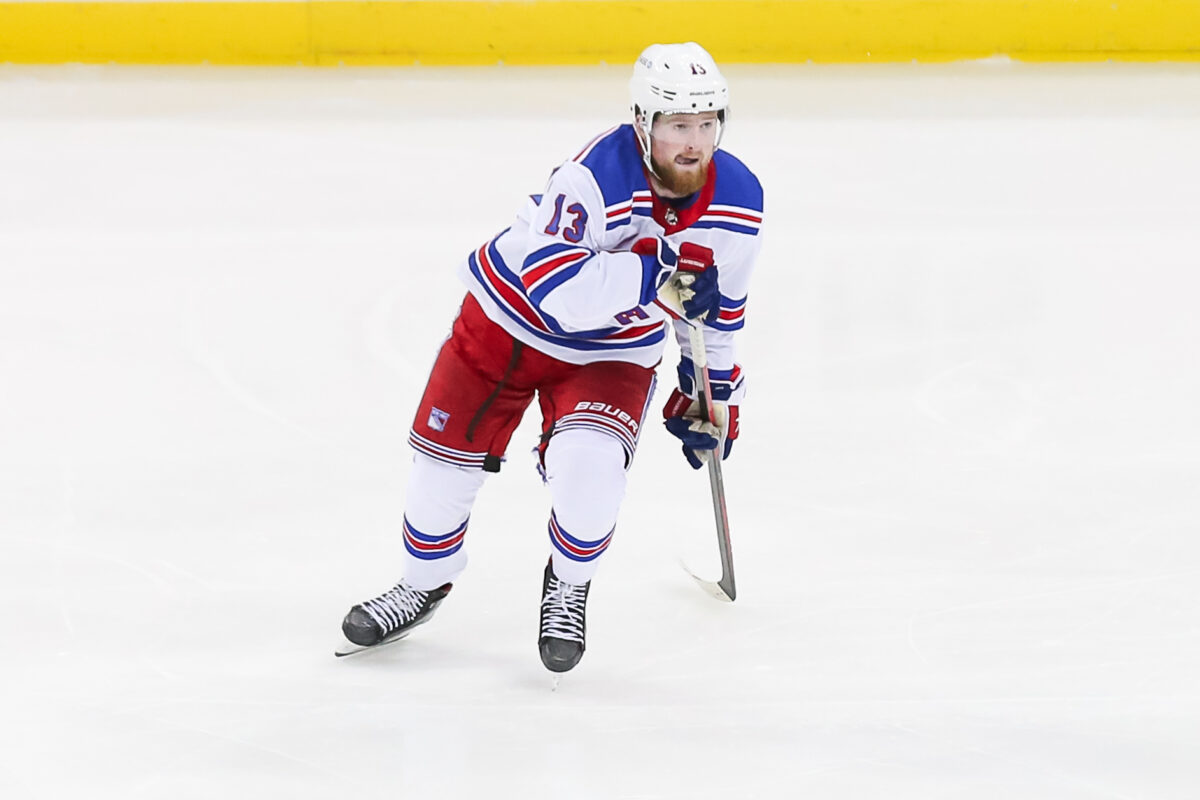
Though Quinn can point to numerous Baby Blueshirts that have gotten better on his watch, he hasn’t coaxed a breakout season from any of the aforementioned first-round draft picks who are expected to form a future core. All of them have flashed at times, but struggles have also followed Lafreniere, Chytil, Kakko and Kravtsov. There’s surely more than one reason for that, but the coach’s handling of them has to be a major consideration when analyzing why.
Rangers’ Power Play Tends to Be a Kid-Free Event
Average ice time per game with the man advantage through Thursday’s games: Panarin, 4:05; Zibanejad, 3:51; Kreider, 3:37; Strome, 3:20; Kakko, 1:21; Lafreniere, 1:17; Chytil, 0:36; Kravtsov, 0:01. This was a philosophical choice, Quinn having attempted to maximize his power-play opportunities via proven track records in the chase for the playoffs.
There’s little question the four veterans are always going to spend time on the power play. There’s even less mystery to Panarin and Zibanejad leading all forwards in PP minutes. But does the breakdown have to be this stark, the first unit fully occupied by the usual suspects? As with Quinn’s refusal to give extended top-six minutes to his kids, the lack of man-advantage time for them represents a lost opportunity to pump up their self-assuredness through more favorable offensive situations – and further boxes them into limited and irregular bottom-six scraps.
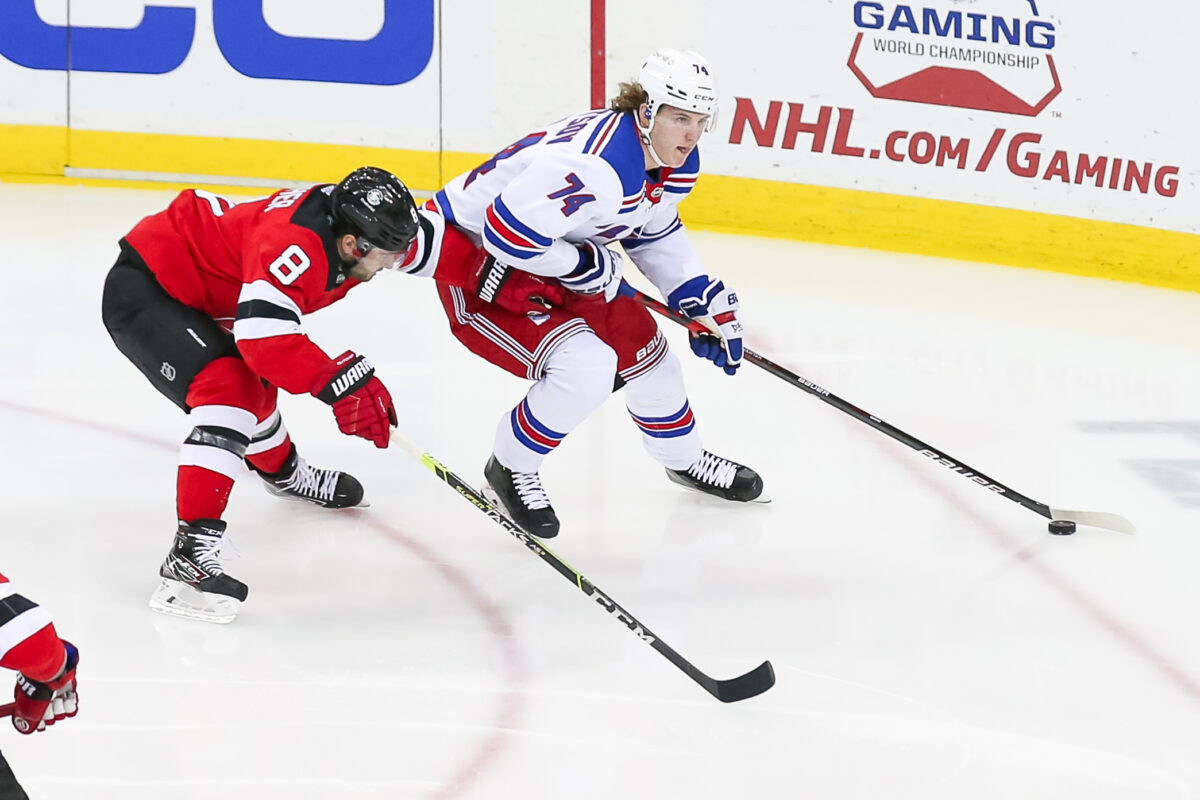
Does that best serve the growth process for players who, in the near future, will be expected to carry the team offensively? Also, it isn’t as if the current philosophy has yielded results that can’t be questioned: the Rangers were 16th in the league in power-play percentage at 20.1 through Thursday’s action. Who’s to say one of the four young guys wouldn’t provide a lift on the first unit?
Which brings us to the next point …
Quinn’s Earn-Your-Time Philosophy Can Be Inconsistent
The coach has preached a steady message since taking the reins: ice time isn’t free for highly-regarded young players here. Earn your minutes with hard work and defensive responsibility. The approach has yielded some results, creating a framework of expectations for young guys looking to establish themselves in the NHL and avoiding a sense of entitlement amongst them that can be poisonous to organizational culture.
Yet, while veterans on any team are expected to get a longer leash, at least a few of the Baby Blueshirts have to have scratched their heads on some occasions. While Quinn is often quick to bench or remove them from the lineup off of a bad game or even a few bad shifts, some of the vets seem all but immune to demotion.
For instance, Kreider’s only even-strength goal in the last 22 games was an empty-netter. He is in the midst of one of his trademark extended stretches of five-on-five invisibility, even if he’s scored three goals in the past five contests. Yet he maintained his spot in the top six before Quinn finally dropped him to the fourth line in a 3-2 overtime loss to the New York Islanders on April 11 – before moving him right back up.
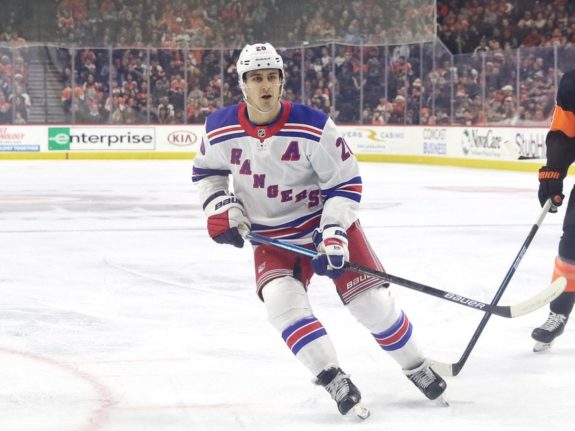
A similar scenario played out at the start of the season as Zibanejad struggled badly before Quinn had no choice but to finally sit him for part of a game.
There’s, of course, a fine line here when it comes to experienced players getting more chances to work their way out of slumps. There can also be a danger of creating a class system on a team, one in which young players feel subjected to a double standard and an inconsistent message.
With Playoffs Probably Out of Reach, Rangers Missed Chance to Push Rebuild Further Forward
The Blueshirts’ slim hopes of catching the Boston Bruins for the fourth playoff spot in the East Division were dealt what might have been a death blow with back-to-back losses to the Islanders and Philadelphia Flyers this week, despite Friday night’s 4-1 win over the Flyers and 6-4 Bruins loss to the Buffalo Sabres that pulled them to within six points. Boston remains in control with two games in hand on the Rangers.
With eight games remaining and the postseason looking increasingly elusive, Quinn may start to increase ice time for his youth – but that’s not necessarily the point.
Would the club have been better served by the kids playing more in meaningful situations all season, experiencing the pressure of what was expected to be a difficult season to make the playoffs, given the Rangers’ grouping in a tough temporary divisional realignment? Running the young players out there en masse now, with those hopes probably extinguished, isn’t the same thing.
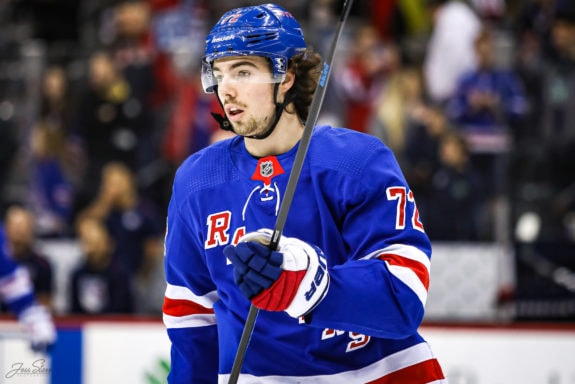
The answer to that question, as mentioned, isn’t easy. Throwing neophyte forwards to the wolves in a division that includes seasoned, tested outfits like the Islanders, Bruins, Washington Capitals and Pittsburgh Penguins can backfire, crushing the self-esteem of guys who are just starting to find their way around the NHL. The Rangers signed Panarin as a free agent and extended Kreider’s contract last season in no small part to help ease the pressure on a youthful roster to produce right away.
Yet, it’s possible that Quinn grew too reliant on those established players this season as he – and perhaps others in the organization – decided to pursue a spot in the tournament. Again, it’s understandable – everyone wants their team in the playoffs, even if the Rangers’ ability to remain in contention for most of 2020-21 has been admirable in and of itself, given the circumstances of the season.
Should the Rangers fail to make the postseason, however, can the front office and coaching staff say they learned enough about the future in these 56 games to make fully informed personnel decisions going forward? Team president John Davidson and general manager Jeff Gorton have repeatedly stressed doing the rebuild right and not cutting corners and the patience that it will require. Did this season honor that?
Finally, how does Quinn approach next season? Assuming the Rangers do miss the playoffs, does that increase the urgency to make it in 2021-22, and as a result, mean more big minutes for Panarin, Zibanejad, et al to get them there at the expense of the kids? Or does this season convince those in charge to prioritize the development of youth, regardless of results?
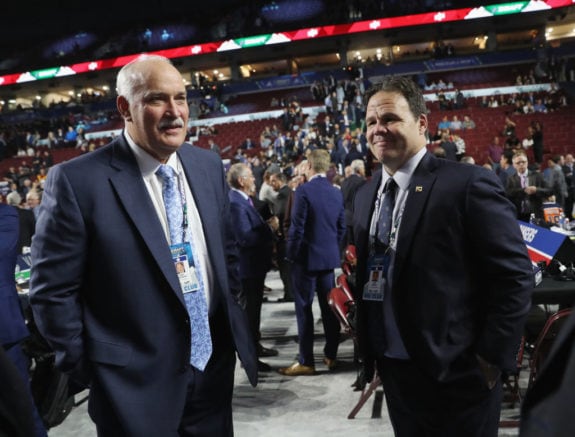
Quinn’s handling of the team this season should be quickly validated or proven faulty next season, through the growth or lack thereof from Lafreniere, Kakko, etc. Yet what this season and next might ultimately prove is how difficult rebuilds are – that making them work as effectively and quickly as possible is about so much more than just collecting young talent.
The path the Rangers have taken in their handling of prized young players is what will make the biggest difference in whether they follow the rebuild arc of the Tampa Bay Lightning or Colorado Avalanche – or languish like the pre-Connor McDavid Edmonton Oilers. It’s too early to know which path the Rangers are on – and how the decisions of 2020-21 might end up playing a role in determining that.